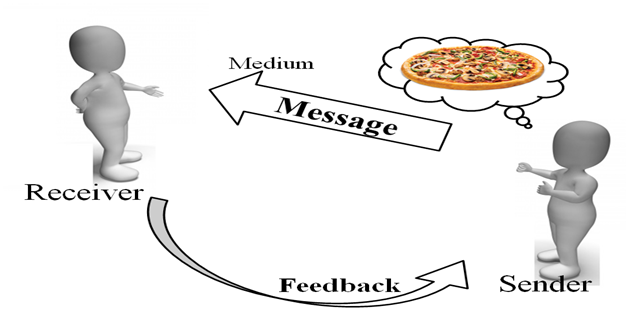3 Purpose, Audience, and Author
When we talk about writing or communicating well in terms of rhetoric, what we mean is thinking carefully about not just what we are saying, but how we say it. Most people use rhetoric instinctively to communicate with different audiences. For example, imagine that you’re telling a story about something that happened over Spring Break. Without even thinking about it, you will likely tell the story differently to your mom and to your best friend. You might emphasize different people or events or leave out the things that you know might interest one party but not the other (or that might get you in trouble). Remembering that rhetoric is something that you already use all the time helps to alleviate any stress about how to use it.
 “Communication Types” by zeeshan93 licensed CC BY-SA 4.0
“Communication Types” by zeeshan93 licensed CC BY-SA 4.0
Purpose, of course, is what an argument hopes to achieve. Most communication occurs because something needs to happen. Writers must think about what they want their readers to do once they’ve read the message. In our shopping list, for example, the purpose would be to go and buy the correct items on the list. If a person purchases a t-shirt with a logo or slogan, the purpose might be to show support for that brand. It’s telling your audience—the people who look at your shirt—to think about you a certain way or to think about a topic a certain way. If someone wears a Yavapai College t-shirt, they are telling their audience that they go to YC and are proud of it! So, whenever you write, think about the purpose. What is the end result you are hoping to achieve? What do you want the reader to do with what you’re telling them? The best writing will always have a clear purpose.
A writer’s purpose is very often related to the audience. The audience consists of the specific person or group or groups of people for whom the message is intended. Knowing and understanding the audience is vital for successful communication and accomplishing the purpose. Look at our shopping list example again. The amount of detail the author might provide in the list depends greatly on the intended audience. In an academic setting, many students think of their instructor as their audience. However, while your instructor is grading your papers, the message or the purpose should not be related to your instructor. Your instructor is grading how effective you are at getting your message across to your intended audience–NOT to them. If you are not given a specific audience, or you aren’t sure, a good solution is to write for an audience of your peers. This allows you to define your audience, which will help you to craft papers that are more interesting, not only for you to write and your audience to read, but also for your secondary audience–your instructor!
The final element of our rhetorical situation is the author. The position and the persona of the author may seem unimportant. However, the writer is always in the text, and how an author portrays him/herself can be very important in getting the message across. Let’s go back to our shopping list example just one more time. It might seems that the persona of the author isn’t very important in this instance–after all, it’s just a list. But imagine that the teenage daughter receives a text message with this list. Perhaps the there are some items spelled incorrectly. This might tell her that it was not her mother, but her little brother sending the list. Can you see how that might impact whether or not she chooses to go to the store to purchase those items? How you portray yourself in a text is important! After all, most writers want to be taken seriously. Even satirical writing usually has a clear purpose that the author hopes to portray. When you’re writing an academic paper, you want to present yourself as a credible source of information. What does that mean? In part, it means using proper grammar and formatting and making sure your words are spelled correctly. Doing these things show the audience that you are serious about the topic and professional. Using good sources and citing them correctly, giving examples, and showing that you understand all sides of an issue tells readers that you are knowledgeable and that you can be trusted. If you don’t portray yourself well in your writing, your message may not be taken seriously–even worse, it may turn your audience against you.
Can you see how these three elements–purpose, audience, and author–work together to create good communication? When writing, it’s important to think about not just what you have to say, but how you say it. And how you say it should be determined by a careful examination of your purpose, audience, and the persona you want to project as a writer.
“Purpose, Audience, and Author” content created by Dr. Karen Palmer and licensed under CC BY NC.
